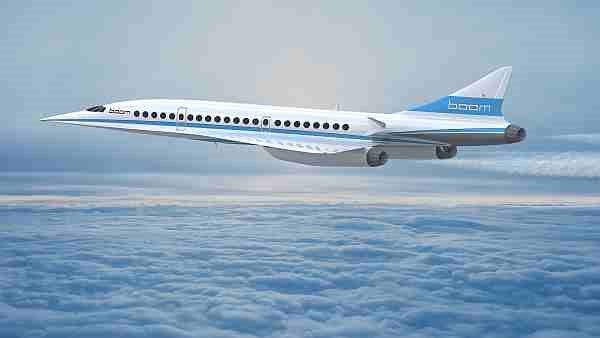Is supersonic flight making a comeback?
Boom Technology (Denver, CO, US), a 2014 start-up aircraft developer, is in the process of building the XB-1, a flying 1/3-scale demonstrator of its supersonic (faster than sound) commercial aircraft.

A new supersonic passenger aircraft is being developed in Denver, CO, US.
Boom Technology (Denver, CO, US), a 2014 start-up aircraft developer, is in the process of building the XB-1, a flying 1/3-scale demonstrator of its supersonic (faster than sound) commercial aircraft. A mockup of the demonstrator was recently on display at the company’s hangar at Centennial Airport near Denver. XB-1 is intended to demonstrate in flight the key technologies for practical supersonic travel, says the company.
Boom Technology’s founder is CEO Blake Scholl, a pilot with a background at Amazon and the founder of Kima Labs. Co-founder and chief engineer is Joe Wilding, who has played leadership roles on multiple aircraft certification programs, including the Adam A700 light jet. Co-founder and chief technology officer Josh Krall, with a background in physics simulation, has developed multi-disciplinary optimization algorithms and design software for the program. At the November open house, the three described the ideas behind the endeavor.
They believe they have a viable business case for the airlines, one that bests the previous longest-flying supersonic transport, the Concorde, jointly developed and built by Aerospatiale and British Aircraft Corp. (BAC) and ultimately retired in 2003. A typical round-trip ticket on the Concorde cost about $20,000 and fuel burn was 6,800 gallons per hour, but the trip between New York and London took about 3.5 hours; the Concorde was retired due to declining sales and rising costs, an accident and the overall post-9/11-caused aviation downturn. According to Boom, their 45-seat jet will be 2.6 times faster than conventional passenger jets, yet cost flyers about $5000 per seat, round trip, in line with today’s business class tickets. Bulky lay-flat seats aren’t needed, since overwater flights will take less than half the time of current flights (thus, little to no jet lag). The group’s preliminary design goal is a speed of Mach 2.2 (faster than the Concorde’s Mach 2) with a 9,000 nautical mile range. Sir Richard Branson of Virgin has already publicized his intention to buy 10 of the craft. The company has an impressive Advisory Board, including Frank Cappuccio, former executive vice president and general manager of Lockheed Martin Skunk Works, Tom Hartmann, another Lockheed Martin Skunk Works director, who was in charge of LM’s Quiet Supersonic Transport program, and Scott Bledsoe, formerly with Gulfstream’s supersonic program and now president of Blue Force Technologies. Astronaut and test pilot Capt. Mark Kelly is also on the board.
So how will Boom bring profitable supersonic air travel? According to the company’s web site, passengers want to get to their destinations faster. But, the viability of supersonic flight depends on reducing operating costs sufficiently (i.e., lower fuel burn) coupled with reasonable fares travelers are willing to pay for the speed; according to Boom, this requires just a 30% efficiency improvement over Concorde’s airframe and engines, with composite materials playing a role, says the company. With more than 1,000 simulated wind tunnel tests already done, three major innovations include an “area ruled fuselage” (the aft cabin will be tapered to reduce cross-section), a chine or wing extension towards the nose for balance and control at supersonic speeds, and a refined delta wing with a swept trailing edge that reduces supersonic drag and quiets the sonic boom.
Carbon fiber composites will be used throughout the airframe, for lighter weight and to counteract the significant growth and expansion that the Concorde’s aluminum design experienced in flight. The XB-1 demonstrator will be powered by three General Electric turbojet engines with shaped variable geometry inlets. Acknowledging that a ban on supersonic flights still exists over the US, the company says the jet will begin with overwater routes, such as New York to London or San Francisco to Tokyo. The sonic boom from a Boom jet will reportedly be much quieter than the Concorde’s. Boom Technology says that its XB-1 will begin test flights in late 2017, starting in Colorado, then moving to Edwards AFB in California. Watch the video explaining the company’s vision here: http://boomsupersonic.com/, and a behind-the-scenes look at the XB-1 here: http://boomsupersonic.com/xb-1/
Related Content
Composites manufacturing for general aviation aircraft
General aviation, certified and experimental, has increasingly embraced composites over the decades, a path further driven by leveraged innovation in materials and processes and the evolving AAM market.
Read MoreThe lessons behind OceanGate
Carbon fiber composites faced much criticism in the wake of the OceanGate submersible accident. CW’s publisher Jeff Sloan explains that it’s not that simple.
Read MoreCryo-compressed hydrogen, the best solution for storage and refueling stations?
Cryomotive’s CRYOGAS solution claims the highest storage density, lowest refueling cost and widest operating range without H2 losses while using one-fifth the carbon fiber required in compressed gas tanks.
Read MorePlant tour: Albany Engineered Composites, Rochester, N.H., U.S.
Efficient, high-quality, well-controlled composites manufacturing at volume is the mantra for this 3D weaving specialist.
Read MoreRead Next
Plant tour: Daher Shap’in TechCenter and composites production plant, Saint-Aignan-de-Grandlieu, France
Co-located R&D and production advance OOA thermosets, thermoplastics, welding, recycling and digital technologies for faster processing and certification of lighter, more sustainable composites.
Read More“Structured air” TPS safeguards composite structures
Powered by an 85% air/15% pure polyimide aerogel, Blueshift’s novel material system protects structures during transient thermal events from -200°C to beyond 2400°C for rockets, battery boxes and more.
Read MoreDeveloping bonded composite repair for ships, offshore units
Bureau Veritas and industry partners issue guidelines and pave the way for certification via StrengthBond Offshore project.
Read More






















